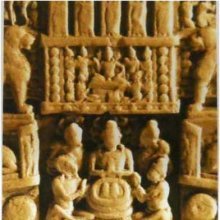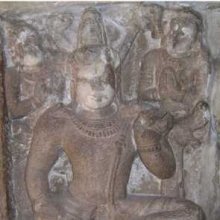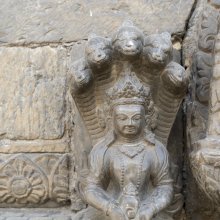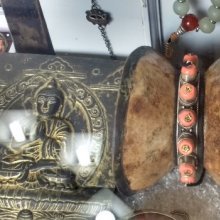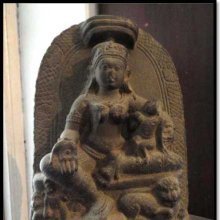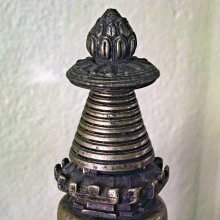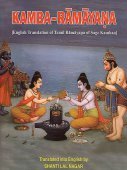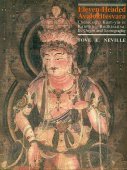Decoration: 1 definition
Introduction:
Decoration means something in Hinduism, Sanskrit. If you want to know the exact meaning, history, etymology or English translation of this term then check out the descriptions on this page. Add your comment or reference to a book if you want to contribute to this summary article.
Images (photo gallery)
(+4 more images available)
In Hinduism
Natyashastra (theatrics and dramaturgy)
Source: Shodhganga: Elements of Art and Architecture in the Trtiyakhanda of the Visnudharmottarapurana (natya)Decoration or Ornamentation (in Sanskrit drama) is expressed through Vācikābhinaya, which represents one of the four divisions of Abhinaya or “ways to convey or represent one’s emotion to others” (in Sanskrit Drama), according to the Viṣṇudharmottarapurāṇa, an ancient Sanskrit text which (being encyclopedic in nature) deals with a variety of cultural topics such as arts, architecture, music, grammar and astronomy.—Abhinaya (“acting”) is of four varieties, according to the Viṣṇudharmottarapurāṇa. Āhāryābhinaya is conveyed by decoration or ornamentation. In the Nāṭyaśāstra, it is said that the entire production of a play depends on āhāryābhinaya and the extraneous representation deals with the rules of costumes and make-up. Till today, this process is followed and the actors go for their make-up in the greenroom which is generally situated in the back stage.

Natyashastra (नाट्यशास्त्र, nāṭyaśāstra) refers to both the ancient Indian tradition (shastra) of performing arts, (natya—theatrics, drama, dance, music), as well as the name of a Sanskrit work dealing with these subjects. It also teaches the rules for composing Dramatic plays (nataka), construction and performance of Theater, and Poetic works (kavya).
See also (Relevant definitions)
Partial matches: Decoration, Te.
Query error!
Full-text (+1192): Abharana, Bhushana, Alamkara, Vibhusana, Nepathya, Bhusa, Sajja, Mandana, Vibhusa, Haritalaka, Alankarana, Parishkara, Pratikarman, Lalaman, Prasadhana, Aharya, Sharirasamskara, Parishpanda, Prasadhanavidhi, Bhuti.
Relevant text
Search found 185 books and stories containing Decoration, Decorations, The decoration; (plurals include: Decorations, Decorationses, The decorations). You can also click to the full overview containing English textual excerpts. Below are direct links for the most relevant articles:
The backdrop of the Srikanthacarita and the Mankhakosa (by Dhrubajit Sarma)
Part 2 - Dress and decoration (found in the Śrīkaṇṭhacarita) < [Chapter IV - Socio-cultural study of the Śrīkaṇṭhacarita]
Introduction: Socio-cultural study of the Śrīkaṇṭhacarita < [Chapter IV - Socio-cultural study of the Śrīkaṇṭhacarita]
Cosmetics, Costumes and Ornaments in Ancient India (by Remadevi. O.)
3.6. Ornamental Painting < [Chapter 1 - Cosmetics]
1.3. Materials: Flowers < [Chapter 3 - Ornaments]
2.7. Pharmaceutical use of Keśarāga (Hair dye) < [Chapter 1 - Cosmetics]
Garga Samhita (English) (by Danavir Goswami)
Verses 6.18.33-34 < [Chapter 18 - In the Course of Describing the Glories of Siddhāśrama, a Description of the Rāsa-dance Festival]
Verse 1.10.41 < [Chapter 10 - Description of the Birth of Lord Balarāma]
Verse 3.7.27 < [Chapter 7 - The Holy Places of Śrī Girirāja]
Vastu-shastra (Introduction to Indian architecture) (by D. N. Shukla)
Chapter 7 - The Principal Components < [Volume 3 - House Architecture]
(i) Viśvakarmā’s Vastuśāstra (Summary) < [Chapter 5 - Study of Hindu Science of Architecture]
Chapter 10 - The Defects of the House < [Volume 3 - House Architecture]
Pallava period (Social and Cultural History) (by S. Krishnamurthy)
Crowns for Men (b): Karanda-makuta < [Chapter 4 - Material Culture of the People]
Waist-band (Kati-sutra) < [Chapter 4 - Material Culture of the People]
Head-dress of Women (d): Kirita-makuta < [Chapter 4 - Material Culture of the People]
The Structural Temples of Gujarat (by Kantilal F. Sompura)
1.1. The Pillars of the Mandapa < [Chapter 14 - The vertical parts of the Mandapa]
Chapter 17 - Decorative Sculptures and their Structural Functions < [Part 2, Section 3: The Architectural Canons]
1.3. Temples at Dhamlej (Junagadh) < [Chapter 5 - Structural temples after the end of the Caulukyan period (upto 1600 A.D.)]
Related products
